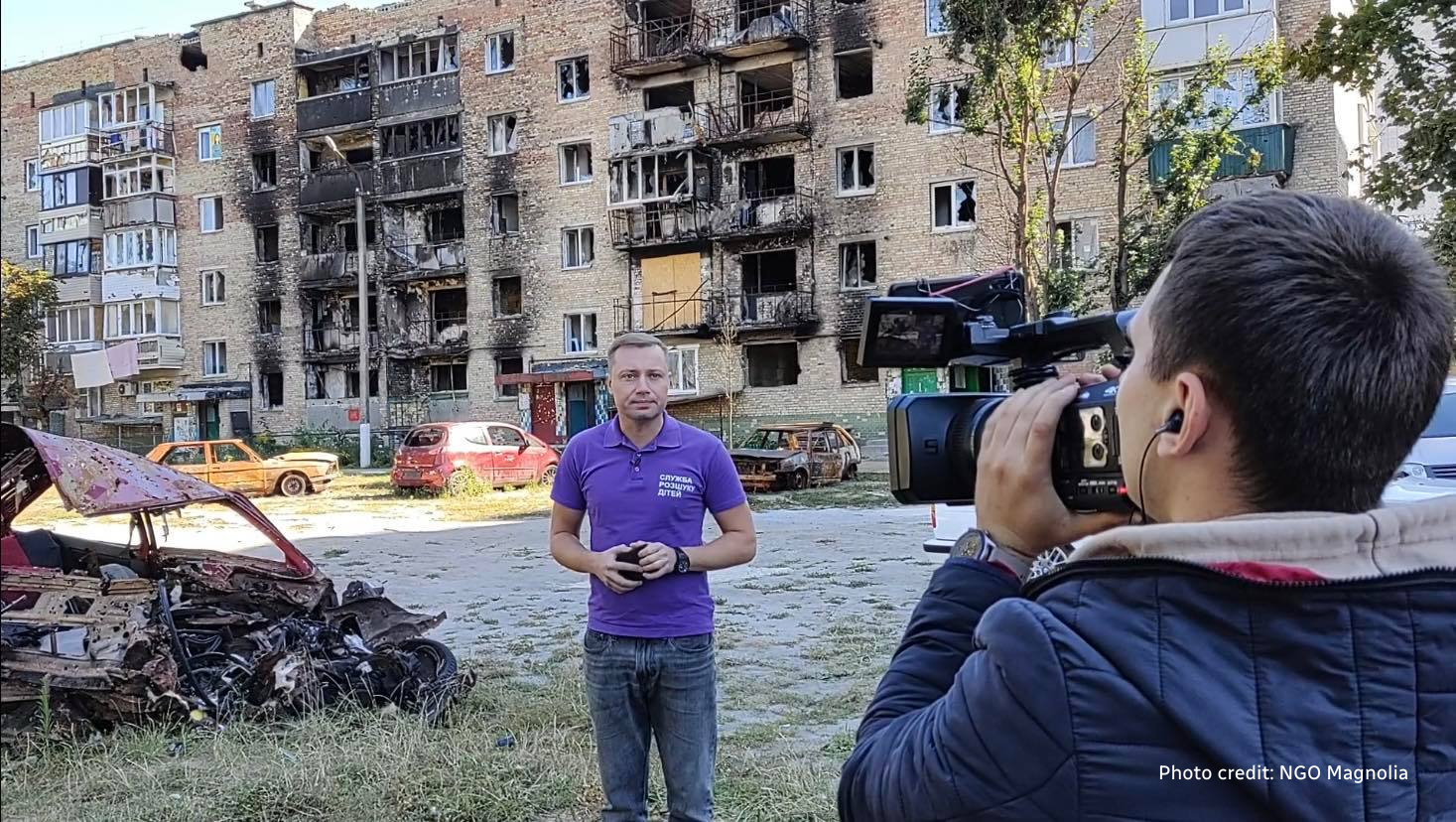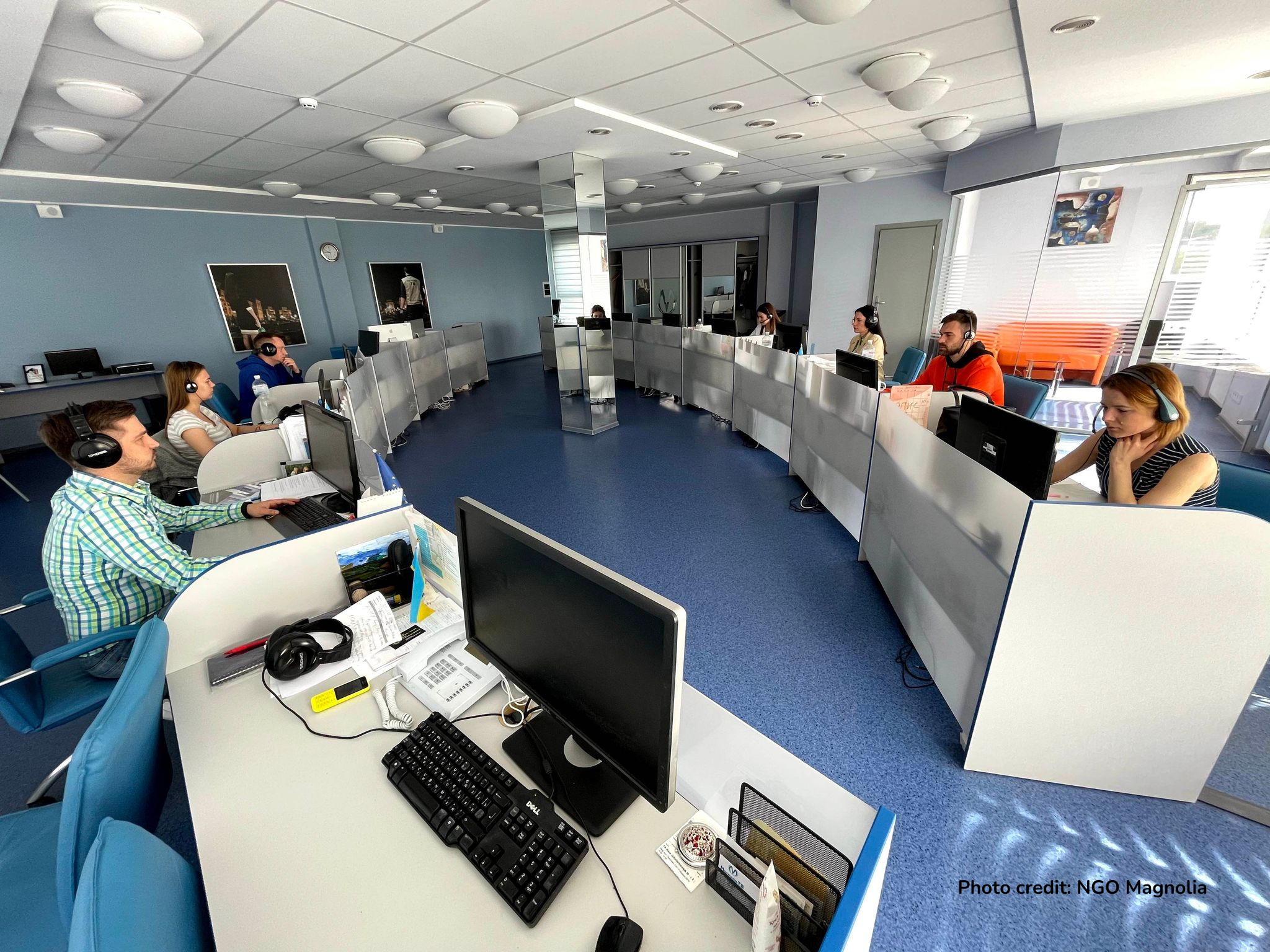Tracking Missing Children Amid War
It is hard to find a Ukrainian who has not heard of Magnolia. Initially a TV company and later a nongovernmental organization, it has been searching for missing children since the 1990s. With Russia’s invasion, the organization faces new challenges—children are now missing in Ukraine’s temporarily occupied territories or in European countries, or they have been forcibly taken to Russia. Magnolia’s projects director, Marina Lypovetska, shares how they cope.
Magnolia has been around for decades. How has the situation with missing children changed over different periods?
Magnolia was created by a group of journalists who believed that the media could help find missing children. The idea was to spread information about the search as widely as possible. Before the organization, there was a 1990s TV program called Children Search Service. We still have recordings of our journalists, along with police and social service representatives, searching for children in manholes. In the early 1990s, so-called “street children” were a serious problem. Many families had no money; sometimes parents struggled with alcohol or drug addiction. Children from such families ran away from home and formed groups. Sometimes they were drawn into criminal activities.
In 2001, Magnolia was officially registered as a nongovernmental organization. The situation got significantly better during those years. The standard of living rose, and social services improved. The problem didn’t disappear entirely—every country has missing children. But we breathed a sigh of relief.
Then, in 2014, part of Ukraine’s territory came under Russian occupation, and new challenges arose. For example, children from social institutions who were evacuated to controlled territory sometimes tried to escape. They wanted to return, hoping to find relatives there. But there was the line of demarcation, minefields—it was dangerous. So, we adapted and started not only searching for missing children but also trying to prevent such escapes.
How has the situation changed since the full-scale invasion began?
Before the invasion, we received 300 to 370 requests annually. Early in the invasion, hundreds of messages came in, turning into thousands. The situation was horrifying, with entire families disappearing.
A missile damaged communications, stopping our hotline. But we understood the need to react very quickly and give people a chance to report missing children as soon as possible. So, we created a chat-bot on our website and social media.
Our team scattered—some joined the armed forces, some went abroad, and some stayed in Kyiv. I personally hid in a basement near Kyiv. Mobile service was poor then, but the internet remained, allowing us to receive messages.
Besides traditional TV programs with information about missing children, we started emphasizing social media. The internet is everywhere—even in occupied territories where Ukrainian television doesn’t work. Before the invasion, Magnolia employed more than 50 people; now there are 18. Due to limited resources, we had to pause our TV channel and focus on directly searching for and protecting children.

What are the main scenarios for children going missing during the war?
The most difficult cases now are children who disappeared in occupied territories or were deported to Russia. There, they might even have their names and surnames changed to make the search impossible. We do not deal with the physical return of children; our main task is to establish where the child is. Then parents, together with ombudsmen and public or government organizations, organize their return.
The second category is children who went missing during evacuation to European countries. The situation with this is better now since the panic of the early invasion has subsided, and border control is stricter. However, there are still cases of Ukrainian children getting lost in European countries. Sometimes they run away due to bullying by peers in local schools.
The third group is children who went missing in territories controlled by Ukraine. The reasons vary—some children ran away from home, but there are also criminal cases. The hardest are the reports after another missile strike on homes and shopping centers. In such cases, children are most often found dead.
How have the tools and approaches you use to search evolved over time?
We started when the internet and mobile communication were not widespread. Parents from all over Ukraine wrote letters, enclosed photos, and sent them by train conductors to our office in Kyiv. Our employee picked them up at the station several times a day—it was faster than mail.
People who saw these children somewhere would call us on a landline. With the spread of the internet and mobile communication, the whole process sped up significantly.
In 2016, we learned that a single hotline for missing children—116 000—was operating throughout Europe. In many countries, it was implemented centrally following a decision of the European Commission. We are still not in the EU, but we wanted our people to have the same quality of services and access. Therefore, Magnolia initiated Ukraine’s joining this initiative. Since then, this number has been working here too. The hotline serves several purposes. Parents calling to report a missing child receive immediate psychological help and legal support—we help them navigate documents and the next steps. Also, people call this line if they see a child who is missing.

As an organization, we generally act as coordinators. For example, if a child was reported missing in Kyiv and went to Odesa, the Odesa police would not know about the search. Through various channels, we spread information about disappearances across the country and cooperate with the police in all regions.
In 2017, Magnolia joined Missing Children Europe, which unites public organizations in 32 European countries, on behalf of Ukraine. Its representatives were impressed that we have socially responsible media that spread information about missing children for free. Today, 19 Ukrainian TV channels support us, plus outdoor advertising agencies, thanks to which we have billboards, citylight posters, and announcements in public transport.
I know you are also now assisted by OSINT (open source intelligence) specialists. How exactly?
Yes, this is our newest tool. The president of Magnolia once heard on the news that OSINT specialists helped find Russian soldiers who committed war crimes in Ukraine. She thought that if they could find soldiers, they could probably find children too. We approached several organizations that agreed to help us. And it worked!
For example, a mother from the Vinnytsia region contacted us. Her daughter was with her father in occupied Kherson. People from the occupation administration came to him, forcibly took the child and her documents. Using facial recognition technology, OSINT specialists found a photo in one of the Russian propaganda Telegram channels. It showed children taken by Russians for a vacation in Crimea, and among them was our girl.
Using the background in the photo, they were able to determine where in Crimea the photo was taken. Even if OSINT specialists cannot establish the exact address where the child is now, such clues are very helpful. We provided all the information to the mother and advised her on which organizations to contact. As a result, the girl was returned to her mother.
Deportation of children is a war crime. How do you, as a public organization, act in such cases?
We always pass information about deported children to the relevant state structures, cooperating with the Office of the Prosecutor General and the ombudsman. They can use this information for the return of these children and as evidence in prosecuting at least Vladimir Putin and Russian Commissioner for Children’s Rights Maria Lvova-Belova as the International Criminal Court has issued arrest warrants for them.
Often, the work of public organizations involves protecting the rights of citizens violated by the state. But in this situation, our rights are violated by the government of another state. Therefore, we have a common strategy with our officials.
What are the current statistics on missing children?
Since the invasion began, we have received over 3,000 requests, mostly in the first weeks. We still receive 70 to 100 requests a month. Currently, 180 children are still missing—the fate of all others has been established. Most are alive.
But not all parents of missing children contact us; the police statistics are higher, and the overall situation is more difficult. Yet, the dynamics are positive. Our hotline is working again, and the internet is available, so the search time has been reduced.
Now, I hear more and more from international organizations about postwar recovery. This is important, but to make future plans we need to have someone to build that future with. That is our focus.